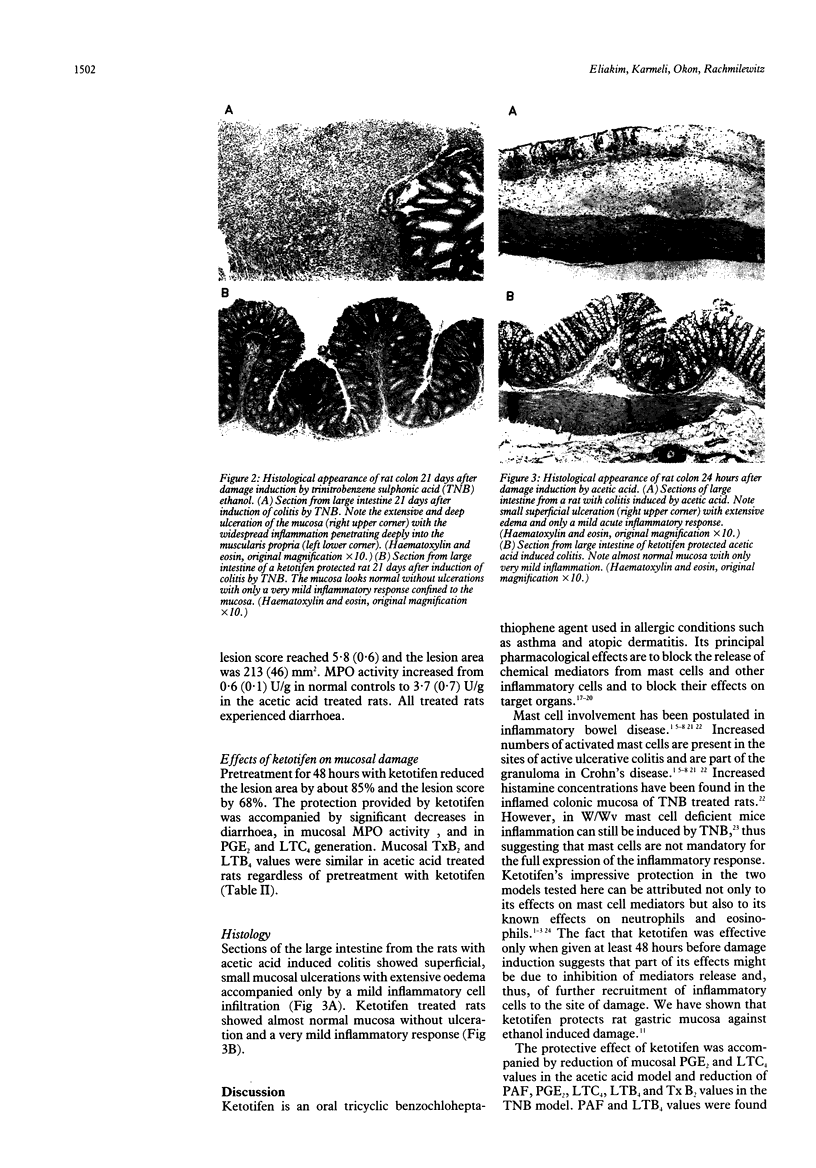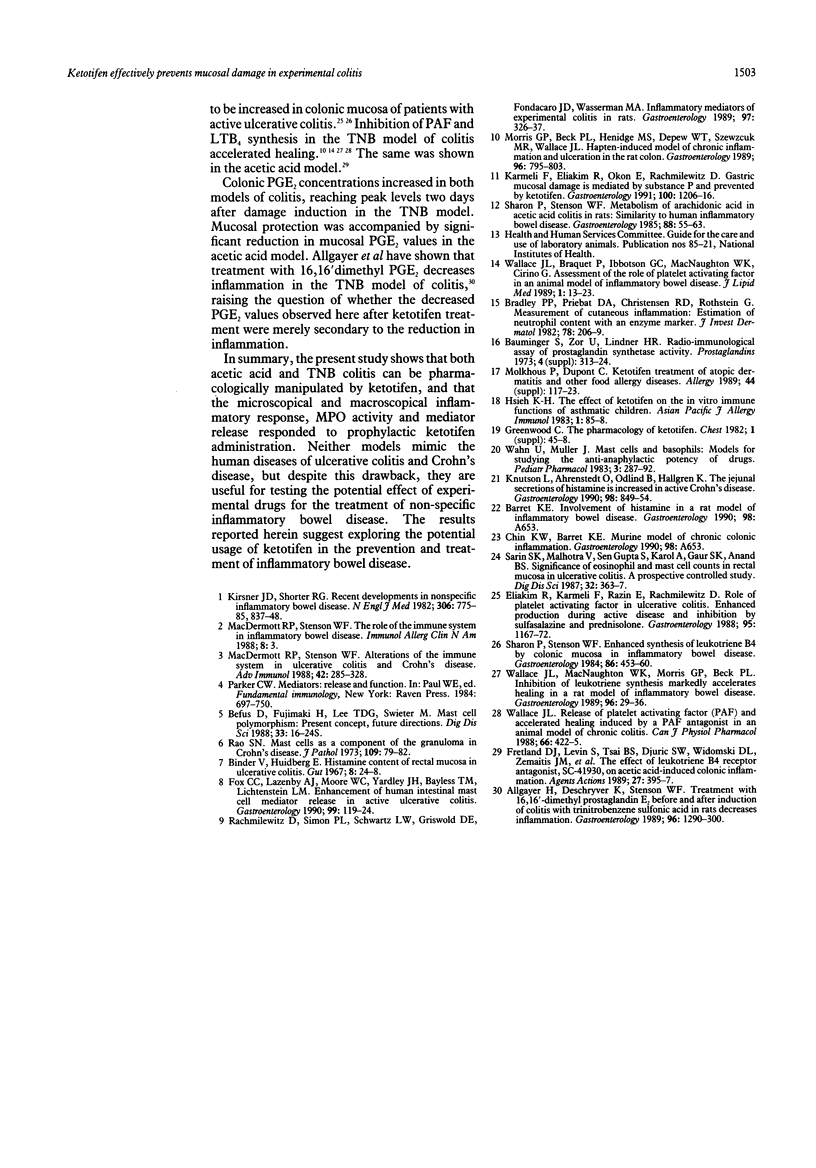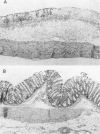Abstract
The effects of ketotifen, a 'mast cell stabiliser,' on two models of experimental colitis were examined. The inflammatory response elicited by either trinitrobenzene sulphonic acid or acetic acid resulted in increased colonic synthesis of platelet activating factor, prostaglandin E2, thromboxane B2, leukotrienes B4 and C4, and myeloperoxidase activity. Intragastric administration of ketotifen 100 micrograms/100 grams twice daily significantly decreased mucosal damage when given prophylactically 48 hours before the induction of colitis and then throughout the experiment. This effect was consistent in both models and was accompanied by a significant reduction in mucosal generation of platelet activating factor, prostaglandin E2, thromboxane B2, and leukotrienes C4 and B4. Myeloperoxidase activity was reduced as well, reaching significance only in the acetic acid model. This study shows that both trinitrobenzene sulphonic acid and acetic acid colitis can be pharmacologically manipulated by ketotifen. The mechanism of action of ketotifen has not yet been determined. Ketotifen's potential in the treatment of active inflammatory bowel disease or in the prevention of exacertations, or both, remains to be elucidated.
Full text
PDF





Images in this article
Selected References
These references are in PubMed. This may not be the complete list of references from this article.
- Allgayer H., Deschryver K., Stenson W. F. Treatment with 16,16'-dimethyl prostaglandin E2 before and after induction of colitis with trinitrobenzenesulfonic acid in rats decreases inflammation. Gastroenterology. 1989 May;96(5 Pt 1):1290–1300. doi: 10.1016/s0016-5085(89)80016-2. [DOI] [PubMed] [Google Scholar]
- Bauminger S., Zor U., Lindner H. R. Radioimmunological assay of prostaglandin synthetase activity. Prostaglandins. 1973 Sep;4(3):313–324. doi: 10.1016/0090-6980(73)90019-1. [DOI] [PubMed] [Google Scholar]
- Befus D., Fujimaki H., Lee T. D., Swieter M. Mast cell polymorphisms. Present concepts, future directions. Dig Dis Sci. 1988 Mar;33(3 Suppl):16S–24S. doi: 10.1007/BF01538127. [DOI] [PubMed] [Google Scholar]
- Binder V., Hvidberg E. Histamine content of rectal mucosa in ulcerative colitis. Gut. 1967 Feb;8(1):24–28. doi: 10.1136/gut.8.1.24. [DOI] [PMC free article] [PubMed] [Google Scholar]
- Bradley P. P., Priebat D. A., Christensen R. D., Rothstein G. Measurement of cutaneous inflammation: estimation of neutrophil content with an enzyme marker. J Invest Dermatol. 1982 Mar;78(3):206–209. doi: 10.1111/1523-1747.ep12506462. [DOI] [PubMed] [Google Scholar]
- Eliakim R., Karmeli F., Razin E., Rachmilewitz D. Role of platelet-activating factor in ulcerative colitis. Enhanced production during active disease and inhibition by sulfasalazine and prednisolone. Gastroenterology. 1988 Nov;95(5):1167–1172. doi: 10.1016/0016-5085(88)90346-0. [DOI] [PubMed] [Google Scholar]
- Fox C. C., Lazenby A. J., Moore W. C., Yardley J. H., Bayless T. M., Lichtenstein L. M. Enhancement of human intestinal mast cell mediator release in active ulcerative colitis. Gastroenterology. 1990 Jul;99(1):119–124. doi: 10.1016/0016-5085(90)91238-2. [DOI] [PubMed] [Google Scholar]
- Fretland D. J., Levin S., Tsai B. S., Djurić S. W., Widomski D. L., Zemaitis J. M., Shone R. L., Bauer R. F. The effect of leukotriene-B4 receptor antagonist, SC-41930, on acetic acid-induced colonic inflammation. Agents Actions. 1989 Jun;27(3-4):395–397. doi: 10.1007/BF01972832. [DOI] [PubMed] [Google Scholar]
- Hsieh K. H. The effect of ketotifen on the in vitro immune function of asthmatic children. Asian Pac J Allergy Immunol. 1983 Dec;1(2):85–88. [PubMed] [Google Scholar]
- Karmeli F., Eliakim R., Okon E., Rachmilewitz D. Gastric mucosal damage by ethanol is mediated by substance P and prevented by ketotifen, a mast cell stabilizer. Gastroenterology. 1991 May;100(5 Pt 1):1206–1216. [PubMed] [Google Scholar]
- Kirsner J. B., Shorter R. G. Recent developments in "nonspecific" inflammatory bowel disease (first of two parts). N Engl J Med. 1982 Apr 1;306(13):775–785. doi: 10.1056/NEJM198204013061304. [DOI] [PubMed] [Google Scholar]
- Knutson L., Ahrenstedt O., Odlind B., Hällgren R. The jejunal secretion of histamine is increased in active Crohn's disease. Gastroenterology. 1990 Apr;98(4):849–854. doi: 10.1016/0016-5085(90)90006-m. [DOI] [PubMed] [Google Scholar]
- MacDermott R. P., Stenson W. F. Alterations of the immune system in ulcerative colitis and Crohn's disease. Adv Immunol. 1988;42:285–328. doi: 10.1016/s0065-2776(08)60848-2. [DOI] [PubMed] [Google Scholar]
- Molkhous P., Dupont C. Ketotifen treatment of atopic dermatitis and other food allergy diseases. Allergy. 1989;44 (Suppl 9):117–123. [PubMed] [Google Scholar]
- Morris G. P., Beck P. L., Herridge M. S., Depew W. T., Szewczuk M. R., Wallace J. L. Hapten-induced model of chronic inflammation and ulceration in the rat colon. Gastroenterology. 1989 Mar;96(3):795–803. [PubMed] [Google Scholar]
- Rachmilewitz D., Simon P. L., Schwartz L. W., Griswold D. E., Fondacaro J. D., Wasserman M. A. Inflammatory mediators of experimental colitis in rats. Gastroenterology. 1989 Aug;97(2):326–337. doi: 10.1016/0016-5085(89)90068-1. [DOI] [PubMed] [Google Scholar]
- Rao S. N. Mast cells as a component of the granuloma in Crohn's disease. J Pathol. 1973 Jan;109(1):79–82. doi: 10.1002/path.1711090109. [DOI] [PubMed] [Google Scholar]
- Sarin S. K., Malhotra V., Sen Gupta S., Karol A., Gaur S. K., Anand B. S. Significance of eosinophil and mast cell counts in rectal mucosa in ulcerative colitis. A prospective controlled study. Dig Dis Sci. 1987 Apr;32(4):363–367. doi: 10.1007/BF01296289. [DOI] [PubMed] [Google Scholar]
- Sharon P., Stenson W. F. Enhanced synthesis of leukotriene B4 by colonic mucosa in inflammatory bowel disease. Gastroenterology. 1984 Mar;86(3):453–460. [PubMed] [Google Scholar]
- Sharon P., Stenson W. F. Metabolism of arachidonic acid in acetic acid colitis in rats. Similarity to human inflammatory bowel disease. Gastroenterology. 1985 Jan;88(1 Pt 1):55–63. doi: 10.1016/s0016-5085(85)80132-3. [DOI] [PubMed] [Google Scholar]
- Wahn U., Müller J. Mast cells and basophils: models for studying the antianaphylactic potency of drugs. Pediatr Pharmacol (New York) 1983;3(3-4):287–292. [PubMed] [Google Scholar]
- Wallace J. L., Braquet P., Ibbotson G. C., MacNaughton W. K., Cirino G. Assessment of the role of platelet-activating factor in an animal model of inflammatory bowel disease. J Lipid Mediat. 1989 Jan-Feb;1(1):13–23. [PubMed] [Google Scholar]
- Wallace J. L., MacNaughton W. K., Morris G. P., Beck P. L. Inhibition of leukotriene synthesis markedly accelerates healing in a rat model of inflammatory bowel disease. Gastroenterology. 1989 Jan;96(1):29–36. doi: 10.1016/0016-5085(89)90760-9. [DOI] [PubMed] [Google Scholar]
- Wallace J. L. Release of platelet-activating factor (PAF) and accelerated healing induced by a PAF antagonist in an animal model of chronic colitis. Can J Physiol Pharmacol. 1988 Apr;66(4):422–425. doi: 10.1139/y88-071. [DOI] [PubMed] [Google Scholar]





